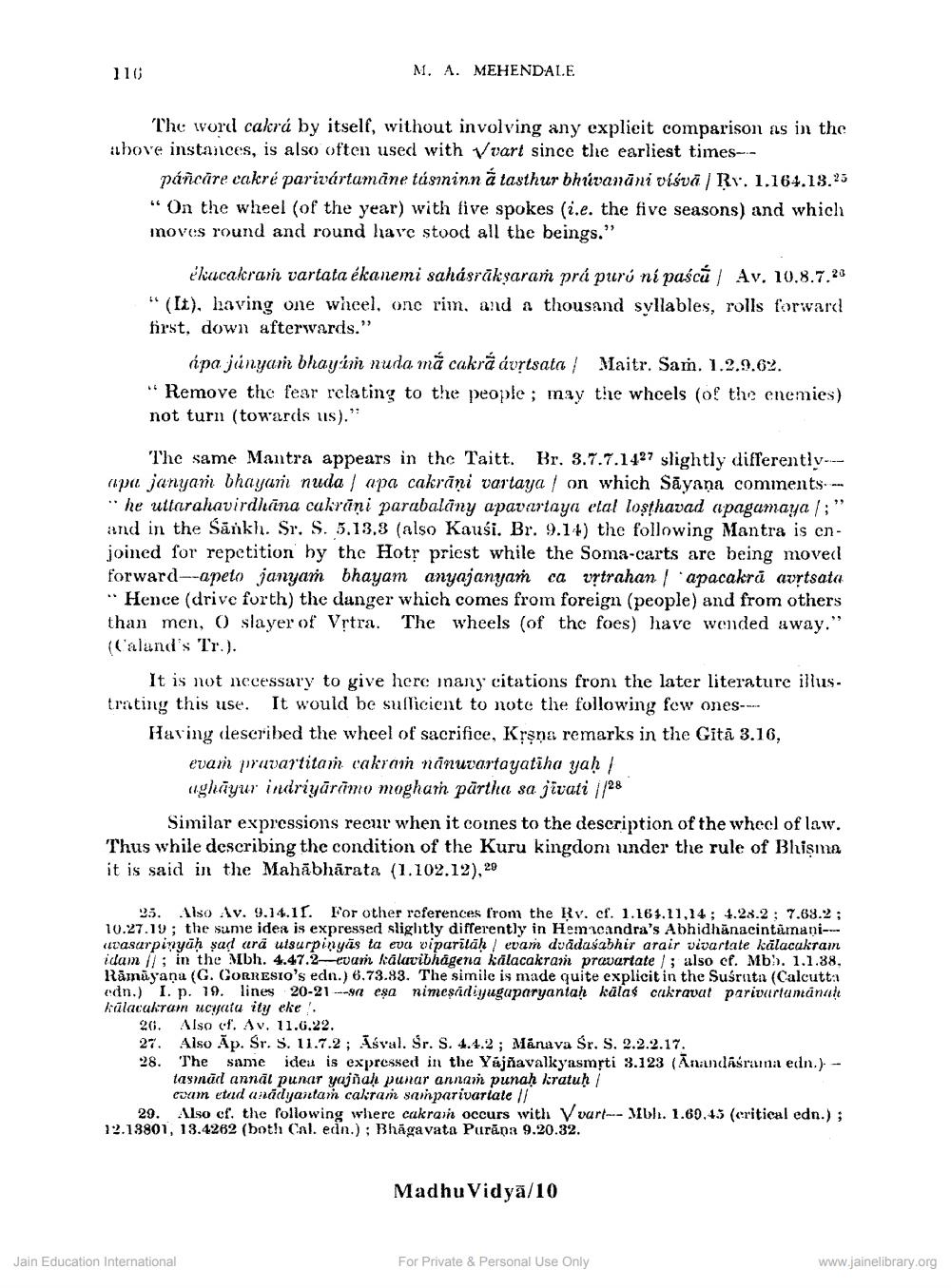________________
110
M.A. MEHENDALE
The word cakrá by itself, without involving any explicit comparison as in the ihove instances, is also often used with Vvart since the earliest times--
páñcăre cakré parivártamane tásminn á tasthur bhuvanāni visva / Rv. 1.164.13.25 "On the wheel (of the year) with five spokes (i.e. the five seasons) and which inoves round and round have stood all the beings."
ekacakram vartata ékanemi sahásrākşaraṁ prá purú ní paścá / Av. 10.8.7.20 "(It), having one wheel, one rim, and a thousand syllables, rolls forward first, down afterwards."
apa jünyam bhayir nuda má cakrá ávrtsata / Maitr. Sam. 1.2.9.62. "Remove the fear relating to the people ; may the wheels (of the enemies) not turn (towards us)."
The same Mantra appears in the Taitt. Br. 3.7.7.1427 slightly differently.-- apa janyam bhayam nuda / apa cakraiņi vartaya / on which Sāyana comments * he uttarahavirdhina cukrini parabalany apavertaya etal losthavad apagamaya/;" and in the Sankh. Sr. S. 5.13,3 (also Kausi. Br. 9.14) the following Mantra is enjoined for repetition hy the Hotr priest while the Soma-carts are being moved forward--apeto janyam bhayam anyajanyan ca vitrahan / 'apacakră avrtsata " Hence (drive forth) the danger which comes from foreign (people) and from others than men, 0 slayer of Vrtra. The wheels (of the foes) have wended away." (Caland's Tr.).
It is not necessary to give here inany citations from the later literature illustrating this use. It would be sullicient to note the following few ones-- Having described the wheel of sacrifice, Krsna remarks in the Gitā 3.16,
evar pravartitam cakran nánuvartayatiha yah /
ghayur indriyārimo moghar pārtha sa jivati //28
Similar expressions recur when it comes to the description of the wheel of law. Thus while describing the condition of the Kuru kingdom under the rule of Blisma it is said in the Mahābhārata (1.102.12),20
23. Also Av. 9.14.11. For other references from the Rv. cf. 1.161.11,14 : 4.28.2 ; 7.68.2 ; 10.27.19; the sume idea is expressed slightly differently in Hemicandra's Abhidhānacintamaniatasarpinyāḥ şad ară utsurpinyās ta eva viparitāk / evam dvādaśabhir arair vivartate kālacakram idam ; in the Mbh. 4.47.
2 evur kalavibhāgena kalacakran pravartate /; also cf. Mb). 1.1.38, Rāmāyaṇa (G. CORRESIO's edn.) 6.73.83. The simile is made quite explicit in the Susrutn (Calcutta edn.) I. p. 19. lines 20-21--90 esa nimeşadiyuguparyantah kālas cakravat parivartamának kālacakram ucyalu ity cke.
20. Also of. Av. 11.6.22. 27. Also Āp. Sr. S. 11.7.2 ; Āsval. Sr. S. 4.4.2: Mänava Sr. S. 2.2.2.17 28. The same ideu is expressed in the Yájñavalkyasmrti 3.123 (nundasrama edn.). -
tasmäd annál punar yajnah punar annan punaḥ kratuh /
caun etad a nádyantar cakran saiparivariate // 29. Also of the following where cakrann occurs with V var. Mh. 1.60.45 (critical edn.) ; 12.18801, 13.4262 (both Cal. edn.): Bhagavata Purana 9.20.32.
ate
Madhu Vidyā/10
Jain Education International
For Private & Personal Use Only
www.jainelibrary.org




